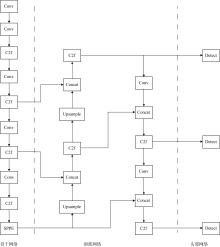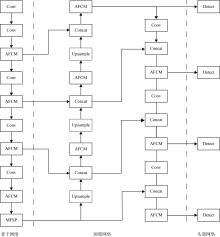| [1] |
陈戈, 杨杰, 田丰林, 等, 2021. 海洋涡旋遥感: 进展与挑战[J]. 遥感学报, 25(1): 302-322.
|
|
CHEN GE, YANG JIE, TIAN FENGLIN, et al, 2021. Remote sensing of oceanic eddies: progresses and challenges[J]. National Remote Sensing Bulletin, 25(1): 302-322 (in Chinese with English abstract).
|
| [2] |
董昌明, 2015. 海洋涡旋探测与分析[M]. 北京: 科学出版社.
|
|
DONG CHANGMING, 2015. Oceanic eddy detection and analysis[M]. Beijing: Science Press (in Chinese).
|
| [3] |
甘滢晖, 2022. 基于遥感资料的中尺度涡与叶绿素分布的关系研究[D]. 大连: 大连海洋大学.
|
|
GAN YINGHUI, 2022. Study on the relationship between mesoscale Vortex and chlorophyll distribution based on remote sensing data[D]. Dalian: Dalian Ocean University (in Chinese with English abstract).
|
| [4] |
高山, 王凡, 李明悝, 等, 2007. 中尺度涡的高度计资料同化模拟[J]. 中国科学(D辑: 地球科学), 37(12): 1669-1678.
|
|
GAO SHAN, WANG FAN, LI MINGKUI, et al, 2007. Assimilation simulation of mesoscale Vortex with altimeter data[J]. Science in China (Series D: Earth Sciences), 37(12): 1669-1678 (in Chinese).
|
| [5] |
沈飙, 陈扬, 杨琛, 等, 2020. 海洋科学中尺度涡的计算机视觉检测和分析方法[J]. 数据与计算发展前沿, 2(6): 30-41.
|
|
SHEN BIAO, CHEN YANG, YANG CHEN, et al, 2020. Computer vision detection and analysis of mesoscale eddies in marine science[J]. Frontiers of Data & Computing, 2(6): 30-41 (in Chinese with English abstract).
|
| [6] |
吴进群, 陈戈, 马纯永, 等, 2023. 深度学习的SAR图像海洋涡旋自动检测及其特征提取[J]. 舰船科学技术, 45(6): 170-173.
|
|
WU JINQUN, CHEN GE, MA CHUNYONG, et al, 2023. Research on automatic detection of oceanic eddies in SAR image and extraction of its characteristic parameters based on depth learning[J]. Ship Science and Technology, 45(6): 170-173 (in Chinese with English abstract).
|
| [7] |
赵文涛, 俞建成, 张艾群, 等, 2016. 基于卫星测高数据的海洋中尺度涡流动态特征检测[J]. 海洋学研究, 34(3): 62-68.
doi: 10.3969/j.issn.1001-909X.2016.03.010
|
|
ZHAO WENTAO, YU JIANCHENG, ZHANG AIQUN, et al, 2016. Dynamic feature detection of mesoscale eddies based on SLA data[J]. Journal of Marine Sciences, 34(3): 62-68 (in Chinese with English abstract).
|
| [8] |
郑晓莉, 董庆, 樊星, 2020. 北太平洋中尺度涡海表温度和叶绿素浓度特征分析[J]. 遥感学报, 24(1): 85-96.
|
|
ZHENG XIAOLI, DONG QING, FAN XING, 2020. Characteristics of sea surface temperature and Chlorophyll concentration inside mesoscale eddies in the North Pacific Ocean[J]. Journal of Remote Sensing, 24(1): 85-96 (in Chinese with English abstract).
|
| [9] |
ALPERS W, BRANDT P, LAZAR A, et al, 2013. A small-scale oceanic eddy off the coast of West Africa studied by multi-sensor satellite and surface drifter data[J]. Remote Sensing of Environment, 129: 132-143.
|
| [10] |
ALPERS W R, ROSS D B, RUFENACH C L, 1981. On the detectability of ocean surface waves by real and synthetic aperture radar[J]. Journal of Geophysical Research: Oceans, 86(C7): 6481-6498.
|
| [11] |
CAZENAVE A, GOUZENES Y, BIROL F, et al, 2022. Sea level along the world’s coastlines can be measured by a network of virtual altimetry stations[J]. Communications Earth & Environment, 3: 117.
|
| [12] |
CHELTON D B, SCHLAX M G, SAMELSON R M, et al, 2007. Global observations of large oceanic eddies[J]. Geophysical Research Letters, 34(15): L15606.
|
| [13] |
CHEN JIERUN, KAO S H, HE HAO, et al, 2023. Run, don’t walk: chasing higher FLOPS for faster neural networks[C]//2023 IEEE/CVF Conference on Computer Vision and Pattern Recognition (CVPR). Vancouver, BC: IEEE: 12021-12031.
|
| [14] |
DONG CHANGMING, MCWILLIAMS J C, LIU YU, et al, 2014. Global heat and salt transports by eddy movement[J]. Nature Communications, 5: 3294.
doi: 10.1038/ncomms4294
pmid: 24534770
|
| [15] |
HUANG DONGMEI, DU YANLING, HE QI, et al, 2017. DeepEddy: a simple deep architecture for mesoscale oceanic eddy detection in SAR images[C]//2017 IEEE 14th International Conference on Networking, Sensing and Control (ICNSC). Calabria: IEEE: 673-678.
|
| [16] |
JOCHER G, QIU J, CHAURASIA A, 2023. Ultralytics YOLO (Version 8.0.0)[Computer software]. https://github.com/ultralytics.
|
| [17] |
KHACHATRIAN E, SANDALYUK N, LOZOU P, 2023. Eddy detection in the marginal ice zone with sentinel-1 data using YOLOv5[J]. Remote Sensing, 15(9): 2244.
|
| [18] |
LIU WEI, ANGUELOV D, ERHAN D, et al, 2016. SSD: single shot MultiBox detector[C]// Computer Vision - ECCV 2016. Cham: Springer International Publishing: 21-37.
|
| [19] |
OUYANG DALIANG, HE SU, ZHANG GUOZHONG, et al, 2023. Efficient multi-scale attention module with cross-spatial learning[C]// ICASSP 2023-2023 IEEE International Conference on Acoustics, Speech and Signal Processing (ICASSP). Rhodes Island: IEEE: 1-5.
|
| [20] |
REDMON J, DIVVALA S, GIRSHICK R, et al, 2016. You only look once: unified, real-time object detection[C]//2016 IEEE Conference on Computer Vision and Pattern Recognition (CVPR). Las Vegas, NV: IEEE: 779-788.
|
| [21] |
REN SHAOQING, HE KAIMING, GIRSHICK R, et al, 2017. Faster R-CNN: towards real-time object detection with region proposal networks[J]. IEEE Transactions on Pattern Analysis and Machine Intelligence, 39(6): 1137-1149.
doi: 10.1109/TPAMI.2016.2577031
pmid: 27295650
|
| [22] |
RIZAEV I G, KARAKUŞ O, HOGAN S J, et al, 2022. Modeling and SAR imaging of the sea surface: a review of the state-of-the-art with simulations[J]. ISPRS Journal of Photogrammetry and Remote Sensing, 187: 120-140.
|
| [23] |
WAN DAHANG, LYU RONGSHENG, SHEN SIYUAN, et al, 2023. Mixed local channel attention for object detection[J]. Engineering Applications of Artificial Intelligence, 123: 106442.
|
| [24] |
WANG C Y, BOCHKOVSKIY A, LIAO H M, 2023. YOLOv7: trainable bag-of-freebies sets new state-of-the-art for real-time object detectors[C]//2023 IEEE/CVF Conference on Computer Vision and Pattern Recognition (CVPR). Vancouver, BC: IEEE: 7464-7475.
|
| [25] |
WANG C Y, YEH I H, MARK LIAO H Y, 2024. Yolov9: Learning what you want to learn using programmable gradient information[C]// European conference on computer vision. Cham: Springer Nature Switzerland: 1-21.
|
| [26] |
XIA LINGHUI, CHEN GE, CHEN XIAOYAN, et al, 2022. Submesoscale oceanic eddy detection in SAR images using context and edge association network[J]. Frontiers in Marine Science, 9: 1023624.
|
| [27] |
XU MING, LI HONGPING, YUN YUYING, et al, 2023. End-to-end pixel-wisely detection of oceanic eddy on SAR images with stacked attention network[J]. IEEE Journal of Selected Topics in Applied Earth Observations and Remote Sensing, 16: 9711-9724.
|
| [28] |
ZHANG DI, GADE M, WANG WENSHENG, et al, 2023. EddyDet: a deep framework for oceanic eddy detection in synthetic aperture radar images[J]. Remote Sensing, 15(19): 4752.
|
| [29] |
ZI NANNAN, LI XIAOMING, GADE M, et al, 2024. Ocean eddy detection based on YOLO deep learning algorithm by synthetic aperture radar data[J]. Remote Sensing of Environment, 307: 114139.
|
 ), 谢涛1,2,3,4(
), 谢涛1,2,3,4( ), 李建1,3,4, 王超1,5, 张雪红1,3,4
), 李建1,3,4, 王超1,5, 张雪红1,3,4
 ), XIE Tao1,2,3,4(
), XIE Tao1,2,3,4( ), LI Jian1,3,4, WANG Chao1,5, ZHANG Xuehong1,3,4
), LI Jian1,3,4, WANG Chao1,5, ZHANG Xuehong1,3,4















